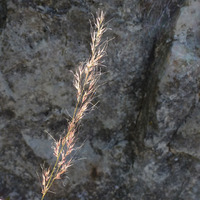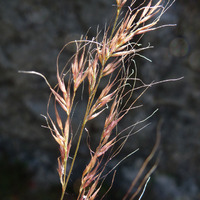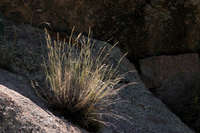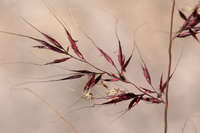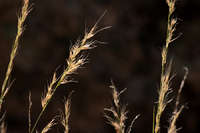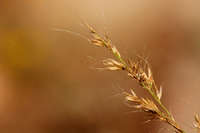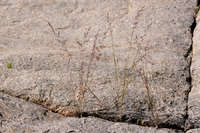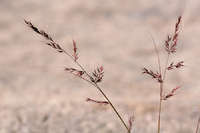Plants perennial; tightly cespitose, sometimes rhizomatous. Culms 30-70 cm tall, 0.7-1 mm thick, erect, geniculate and rooting at the lower nodes; internodes mostly glabrous, sometimes glaucous, often striate below the nodes. Sheaths usually shorter than the internodes, smooth or scabridulous, usually with dark brown necrotic spots, flat and spreading at maturity; ligules 1-2.5(5) mm, membranous, obtuse, with lateral lobes 1.5-3 mm longer than the central portion; blades (1)5-12(15) cm long, 0.5-1.5 mm wide, flat to involute, glabrous and smooth abaxially, scabridulous adaxially, often with dark brown necrotic spots. Panicles (2)5-15 cm long, 0.5-2.8 cm wide, contracted, interrupted below; primary branches 0.5-4(6) cm, appressed or diverging up to 30° from the rachises, spikelet-bearing to the base; pedicels 0.1-3 mm, scabrous. Spikelets3.5-5.5 mm, occasionally with 2 florets. Glumes equal, 1.5-3.5 mm, shorter than the lemmas, 1-veined, acuminate to acute, often erose, unawned or awned, awns to 2.2 mm; lemmas 3-5.5 mm, lanceolate, often purplish, mostly glabrous, calluses with a few short hairs, apices acuminate, scabridulous, awned, awns (5)7-25 mm, flexuous; paleas 3-5.5 mm, lanceolate, glabrous, acuminate; anthers 1.5-2.1 mm, yellowish or purplish. Caryopses 2-2.5 mm, fusiform, brownish. 2n = unknown.
Muhlenbergia pauciflora grows in open or closed forests on rocky slopes, cliffs, canyons, and rock outcrops of granitic or calcareous origin, at elevations of 1200-2500 m. Its range extends from the southwestern United States to central Mexico.
Common Name: New Mexico muhly
Duration: Perennial
Nativity: Native
Lifeform: Graminoid
General: Tightly tufted perennial grass, rarely rhizomatous, with stems 30-70 cm, erect to ascending to spreading, sometimes geniculate and rooting at the lower nodes; internodes glabrous, striate below the nodes.
Vegetative: Blades 5-12 cm long, 0.5-1.5 mm wide, flat to involute, glabrous and smooth below, minutely roughened above, often with dark brown necrotic spots; ligules 1-2.5 mm, membranous, with lateral lobes 1.5-3 mm longer than central portion; sheaths smooth or min
Inflorescence: Contracted panicles 5-15 cm long, 0.5-3 cm wide, interrupted below; primary branches 0.5-4 cm, appressed or diverging up to 30 degrees from the rachises, spikelet-bearing to the base; spikelets 3-6 mm, single-flowered but occasionally with 2 florets; glumes equal, 1.5-3.5 mm, shorter than lemmas, 1-veined, erose, acuminate to acute, unawned or with awns to 2 mm; lemmas 3-5.5 mm, lanceolate, often purplish, mostly glabrous, apices acuminate, minutely roughened, awned; awns 7-25 mm, flexuous.
Ecology: Found on dry rocky slopes and ledges of cliffs, in canyons and on rock outcrops from 4,000-8,000 ft (1219-2438 m); flowers June-November.
Distribution: sw US from se CA, s UT, sw CO, AZ, NM and w TX, south to c MEX.
Notes: Muhlenbergia is a large and diverse genus primarily distinguished by having single-flowered spikelets with unequal glumes. M. pauciflora is a tufted perennial, which is relatively small compared to other tufted Muhlenbergias. It often grows on rock or rock ledges and is sometimes rhizomatous. This species has contracted panicles, which often appear almost racemose, and long, flexuous awns. Other tufted muhlys with long awns are M. montana and M. setifolia, but both of these have panicles that are not wide but much more open than M. paciflora, and both lack geniculate lower stems and rhizomes. M. montana also has distinctively wider leaves, up to 2.5 mm wide, and its lower leaf sheaths are flattened and ribbonlike.
Ethnobotany: Unknown
Etymology: Muhlenbergia is named for Gotthilf Heinrich Ernst Muhlenberg (1753-1815) a clergyman and botanist from Pennsylvania; pauciflora means few flowered.
Synonyms: None
Editor: SBuckley 2010, AHazelton 2015



